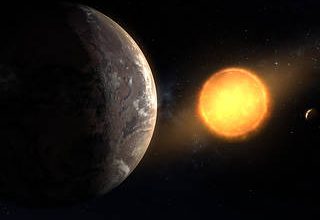What Is the Artemis Program? (Grades K-4)
This article is for students grades K-4.

Artemis is a new NASA program to explore the Moon. These missions will land the first woman and first person of color on the Moon. With the Artemis program, NASA will study the Moon in new and better ways.
Why Is This Program Called Artemis?
The first astronauts landed on the Moon in 1969. The missions were called Apollo. The name Apollo came from stories told by Greek people long ago. In the stories, Apollo was a god.
Apollo had a twin sister. Her name was Artemis. She was the goddess of the Moon in the Greek stories. The first crew will land on the Moon’s South Pole.

What Spacecraft Will Be Used for the Artemis Program?
NASA has a new rocket. It is the Space Launch System. It is called SLS for short. It is the most powerful rocket in the world. SLS will carry the Orion spacecraft on top. Orion can carry up to four astronauts. Orion will fly around, or orbit, the Moon. A spaceship will be orbiting the Moon like the Moon orbits Earth. The spaceship will be called the Gateway. Orion will connect to the Gateway. Astronauts will go from Orion to the Gateway. This is where astronauts will live as they orbit the Moon. The crew will take trips in spacecraft called landers to get to work on the surface of the Moon. Then they will return to Gateway. When all of their work is finished, the crew will return to Earth aboard Orion.

When Will Artemis Go to the Moon?
The first Apollo missions were tests. NASA launched the rocket to be sure it was safe for people and work as planned. Artemis will be tested first, too:
- Artemis 1 will launch SLS and Orion with no astronauts.
- Artemis 2 will have a crew. They will circle past the Moon and return to Earth.
- Artemis 3 will send a crew with the first woman and the next man to land on the Moon.

What Will Artemis Astronauts Do on the Moon?
The Artemis 3 crew will visit the Moon’s South Pole. No one has ever been there. At the Moon, astronauts will:
- Search for the Moon’s water and use it.
- Study the Moon to discover its mysteries.
- Learn how to live and work on a different planet or moon from Earth.
- Test the new tools NASA will need before sending astronauts on missions to Mars. A mission to Mars will take up to three years from Earth and back.

Why Is the Artemis Program Important?
The Moon is a good place to learn new science. NASA will learn more about the Moon, Earth and even the Sun. The Moon is also a place to learn how astronauts can one day live and work on Mars.
The Artemis missions will need new tools. Many companies will make these new tools that NASA will use. This will mean new jobs and new businesses that are good for people and companies on Earth. Other countries will be NASA’s partners for the new Moon missions. They will work on Artemis to bring the world together for a mission to Earth’s nearest neighbor in space.
More About Artemis
Puzzle Book
Pencil and Paper Puzzles: Orion Activities and Coloring Sheets For Kids
Space Launch System Coloring Book (PDF)
Story: What Is the Space Launch System?
Story: What Is Orion?
Story: What Was the Apollo Program?
Read What Is the Artemis Program? (Grades 5-8)
First published at NASA.gov




